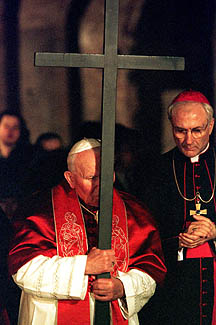![]()
Our Man In Rome

A Mighty Fine Chestnut
Good Friday at the Colosseum, 1999
by Yves Jaques
Presentation: *****
Plot: **
Haptic Response: Yes
Innovation: No
Aristotle says: Thumbs Down
Plato says: Thumbs Up
Rome provides an oxymoronic Easter spectacle that is as comically pompous as it is deeply moving. As the holiday nears its two-thousandth performance, it has like the Phoenix mastered its own death; a duplicity become a necessity in this age of increasing bandwidth and decreasing attention span.
Easter is always a time of spiritual schizophrenia for Christians, the joy of the salvation tempered by Christ’s sacrifice. But in Rome, with its mixed position as seat of the empire that killed Christ, and of the denomination that has most furthered his name this schizophrenia is compounded, for to mourn Christ’s death is to mourn in the way of the executioner.
The Pope, as head of what is essentially the last fragment of the Roman empire, is symbolically both descendant and judge of the executioner. His role at this holiday is amazingly disjunctive: deliverer, mourner, pilgrim, penitent, murderer, king. He presides over Easter with elaborate and regal purpose, and yet the layers of ceremony do nothing more than highlight how delicate is this entire enterprise, this structure by which the spirit and the unknown are mitigated.
Standing at the Colosseum on Good Friday as the Pope visits the dying ground of the Martyrs, the crowd reels with a heady mix of individual expiation and communal atonement. One feels most keenly the uneasy convergence of the individual with the body politic. Manning the mouth of the cordon that will receive the Pope are two public workers. One drinks a beer. The other blithely munches a sandwich. The pilgrims pour in from all sides. Stiff with detached dignity, the carabinieri in their Versace uniforms maintain crowd control. Shiny black cars limp along the cordon. Through their smoked windows the somber figures of cardinals and bishops are dimly seen.
There is a pause, after which a fleet of motorcycle cops shoots through the cordon with impressive speed, followed moments later by a gorgeous, impeccably maintained early 60’s Mercedes sedan. It is the Pope! And with their usual exuberance, the crowd of Italians claps wildly as he passes.
This sudden burst of applause is immediately stifled as John Paul emerges in white and red robes. The crowd regains composure. This is the man, after all. Aided on either side, the Supreme Pontiff moves with reckless haste toward the starkly-lit interior of the Colosseum. The cordon closes. He is gone, and like storm-tossed jetsam the crowd flows in the wake of the procession, tumbling to the foot of the Palatine.
No sooner is the crowd shifted than this well-oiled bit of theater moves to the next act. The Stations begin. And now things get very surreal. One is reminded of the pilgrim scenes in Fellini’s Nights of Caberia, and La Dolce Vita. The movie lights are blinding. Overhead, TV cameras whir and circle on giant dollies. Strange voices blare out of a PA mounted to the top turn of the Colosseum. They drone, whisper and chant in a dozen languages. Squinting up at the speakers, damned if the building doesn’t look something like Bruegel’s Tower of Babel.
"Jesus falls for the first time," calls out an imperious voice, and the ground rumbles with the weight of the subway passing far below in its tube. Cellphones ring, their owners turning away in embarrassment and whispering into the receiver with cupped hands as if receiving communion. The air is very clear. What a marvel this Easter, for in a country where everyone smokes everywhere, no one is smoking.
A cortege at his arm, the Pope emerges from the womb-like building, his phallic cross held high. The procession is entirely male. Like a serpent, it glides through the crowd in the direction of the Palatine hill, stopping every forty feet to perform another Station. John Paul’s bent old back, the slow pace of the ritual, its terrible formality; they deliver against this modern city of smog and Smart cars a curious feel, one that is deeply historic, anachronistic. A feeling that creates the faith it feeds on.
If faith can be defined as the active participation of the spirit in the physical world, its manifestation in Rome on Good Friday is unusually silent. The audience’s passivity is stunning. This is theater, and the crowd’s only real requirement is like children, to be seen and not heard. In our interactive age, where more and more the crowd is become the performance, the relic atmosphere of Catholicism is at the Colosseum very apparent. In contrast with the foot-stomping tradition of the Pentecostalist, who dances at church instead of at the discotech, it is hard to understand how the Pope can take the modern soul.
As John Paul winds down from his speech at the crest of the Palatine, and the curtain comes down, and the crowd disperses, there is little outward grief for the death of a prophet, little outward celebration of man’s coming salvation. No, rather there is the hunt for a caffé and a grappa, and the worry over how long it will take to navigate the choked streets of Rome, and the two-thousand year-old question: Was this year’s show better than the last?
Yves Jaques can be reached at yjaques@tiscalinet.it
